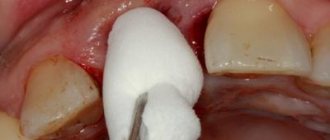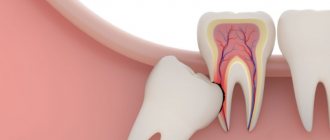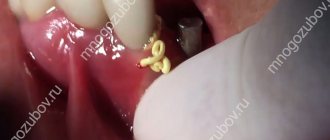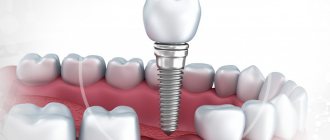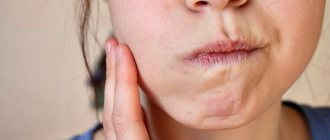Suturing the gums after tooth extraction: when required
On the eve of a surgical operation, patients are often interested in whether it is necessary to apply sutures after removing a tooth - wisdom, canine, incisor. There are certain indications for gum suturing:
- Dental implantation. When choosing a one-stage tooth restoration protocol, the patient must undergo two surgical interventions at once. This is tooth extraction and immediate implantation. In order for the dental implant to take root in the bone tissue without any problems, the doctor will apply sutures and leave the implant in the tooth socket.
- Removing eights. Wisdom teeth are characterized by enlarged roots, an uncomfortable position in the jaw row, and difficulty in extraction. When third molars are removed, soft and bone tissues are severely damaged, heavy bleeding begins, and severe pain is possible. To reduce unpleasant consequences, the doctor places a hemostatic sponge in the hole and sutures the gums after tooth extraction.
Sutures are also indicated when there is a threat of severe bleeding, extraction of dystopic and impacted teeth. The manipulation is also performed at the patient’s personal request.
How do doctors apply stitches?
Sutures are the junction of soft tissues that were cut to remove a wisdom tooth from the socket. As a rule, figure eights “sit” very firmly in the jaw, are attached to the bone by two roots, and sometimes stand unevenly, resting against neighboring teeth. There is no way to do this without a surgical incision.
To carefully remove a molar, the surgeon makes one or two incisions in the gum, after which he loosens the tooth with a special tool and removes it. Bleeding occurs at the root site; sutures are carefully placed with special threads.
The first day after suturing, bleeding should not be too active - it is the sutures that seem to hold it back. They also connect layers of dissected tissue, which naturally grows together. With high-quality sutures, there should be no severe pain or discomfort, and on the third to fifth day after the operation, the person will not feel any swelling of the gums in the operated area.
The sutures prevent infection from entering the open wound. The better the wound is closed with sutures, the lower the risk of complications and accidental infection.
A follow-up visit after surgery is scheduled 5–7 days later. If the patient is bothered by the wound earlier, he makes an emergency visit.
The dentist assesses the condition of the gums, may prescribe an x-ray, and examines the stitches in detail. If the wisdom tooth removal went without complications, the sutures can be removed after a week. If complete healing of the wound has not occurred, the sutures remain for several more days.
Dentistry for those who love to smile
+7
Make an appointment
Why did you sew up the hole after tooth extraction?
If stitches were applied after wisdom tooth removal, this will only be beneficial. Repeated studies have proven that a sutured socket is:
- reducing the risk of infection and complications - by 90%;
- rapid stop of bleeding;
- preservation of the blood clot and natural healing of the wound;
- minimal pain after surgery;
- rapid fusion of tissues thanks to sutures.
Sutures are placed on the socket immediately after the removal operation. After which the doctor gives recommendations for accelerated healing and rapid normalization of the general condition.
What not to do after suturing.
- don't rinse your mouth! Mouth baths in the first 3-5 days are more than enough;
- do not use hot compresses! This is fraught with the appearance of edema and the development of inflammation;
- do not create a vacuum in your mouth: do not puff out your cheeks, sneeze, blow your nose and spit very carefully;
- do not pick the wound, do not touch the clot with your tongue;
- do not drink or eat hot or cold food, only warm food;
- try to quit smoking for at least 2-3 days after surgery;
- Do not drink alcohol for 2-3 days - it does not promote tissue repair. Also rule it out if your doctor has prescribed a course of antibiotics;
- Do not overcool or overheat - give up sports exercises, swimming pools, saunas for 5-7 days.
Types of seams and suture materials
The patient’s further actions depend on what materials and suturing technique the surgeon used in dentistry. There are seams:
- Intermittent - stitches are applied separately, each secured with its own knot. Damage to one stitch does not affect the integrity of the others, allowing you to keep the hole closed.
- Continuous - all stitches are made with one suture thread and have a common knot. If one stitch is damaged, the entire seam comes apart.
Features of suture material:
- Absorbable threads are a sterile material of natural or synthetic composition, which after some time disintegrates into independent elements. During the healing process of the hole, the sutures securely fix the wound and then completely dissolve.
- Non-absorbable compounds are common synthetic threads used by dental surgeons in their work. These are polyester, nylon, silk, monofilament.
The material and features of suturing influence how the sutures are removed after the removal of a wisdom tooth or another unit.
What happens to gum tissue during the implantation process?
There are different types of implants: subosseous implants are inserted into the jaw bone, periosteal implants are inserted into the soft tissues of the jaw. Sometimes the socket of an extracted tooth is used for implantation, but in some cases it is necessary to artificially deepen the socket or completely dissect the gum from the outside - this is done either with a scalpel or a laser.
After the incision, surgical sutures are made on the gums to hold the tissue until it heals completely.
In some cases, after installation of the implant, gum grafting is performed separately - then healing takes several weeks longer.
We sewed up the gum after tooth extraction: when to remove the sutures
Removal of sutures from the gums after tooth extraction is carried out 7-10 days after surgery. The doctor invites you to a follow-up appointment. When examining the patient’s oral cavity, the dentist notes the quality of wound healing and the general condition of the tissues in the area of the extracted tooth.
If healing goes well, the stitches will be removed on the same day.
How long does it take for sutures to dissolve after tooth extraction?
We sewed up the gum after tooth extraction - when the stitches dissolve depends on the material. There are many factors that determine the rate of natural destruction:
- composition - synthetic and natural;
- method of production of threads - what affects the breakdown of the composition;
- individual characteristics of the patient’s body - in particular the state of the immune system;
- the composition of saliva - destruction occurs under its influence.
There are approximate guidelines for when sutures dissolve after wisdom tooth removal, depending on the composition:
- 20-30 days - synthetic self-absorbing sutures after tooth extraction;
- 10-100 days - absorbable materials based on enzymes.
Antiseptic rinses/baths –
Remember that you should not rinse your mouth vigorously during the first few days after removal, because... you can easily rinse the blood clot out of the socket. Food will constantly accumulate in a hole without a clot and rot there, causing inflammation and pain. It is better to replace rinses with baths (pour an antiseptic solution into your mouth, hold it and spit it out, or lightly “squelch” it).
When are antiseptic baths necessary?
- if the tooth was removed due to inflammation,
- an incision was made on the gum to expose the gumboil,
- if you have teeth with untreated caries or dental plaque, infection in which can lead to suppuration of a blood clot.
Antiseptic baths are best done with an aqueous solution of Chlorhexidine 0.05-0.12%. This drug has a pronounced antiseptic effect and is slightly bitter in taste. Baths should be done 3 times a day (keep the solution in your mouth for about 1 minute each time).
How to remove suture threads from a tooth socket
Many people associate the removal of sutures with unpleasant pain. Pain occurs only in people with a low pain threshold, increased sensitivity, or when there is inflammation in the tooth socket. Usually the patient experiences only discomfort.
Stages of removing suture material:
- treating the patient's oral cavity with an antiseptic;
- examination of the mucous membranes for hyperthermia, swelling, suppuration;
- the use of topical anesthesia to prevent even minimal pain;
- cutting the threads with a special dental instrument - the stitches are divided in half, especially in the case of an intermittent suture line;
- removing pieces of thread with tweezers;
- checking the density of the scar and the quality of wound healing.
Next, the patient will be asked to rinse his mouth with an antiseptic composition.
The first three days after the stitches are removed, stiffness of movements and discomfort when opening the mouth are possible.
Possible complications
Pain and swelling of the gums at rest, difficulty chewing, evening fever in the first two days after surgery and suturing are considered normal - this is a response to surgical trauma. If the symptoms increase, it means that a purulent complication is developing. A visit to the doctor is needed, opening the wound with removal of the suture threads, washing it, re-suturing or draining it, and taking antibiotics.
Complications arise when wound hygiene is not observed, infection occurs, or particles of a tooth or root are left in the wound.
Continued bleeding from the surgical area is possible if the stitches come apart.
Seam divergence
If the suture breaks apart after tooth extraction, this may indicate inflammation of the periosteum - periostitis.
When infected, the wound area swells, there is pain, discharge of pus, which can push out the threads, and the edges of the tissue diverge. Healing is delayed, and there is a risk of developing ugly scars.
If the sutures on the gums come apart, it is necessary to visit a surgeon to determine the cause and eliminate it with re-suturing of the wound in the oral cavity.
Maintains healthy gums by maintaining oral hygiene and following the dentist’s recommendations after any dental surgery.
Why do the sutures hurt after tooth extraction?
Unpleasant sensations accompany patients during the first hours after tooth extraction. Traumatic surgery requires some time for the body to recover. When the hole is sutured, the rehabilitation process goes faster, but complications also occur.
Alarming symptoms that require consultation with a doctor are as follows:
- bleeding - unexpectedly resumed or continues for more than a day;
- increasing pain - throbbing, radiating to the ear or neck, interfering with sleep and leading a normal lifestyle;
- growing swelling - of soft tissues in the oral cavity or even on the face from the side of the extracted tooth;
- redness and hyperthermia in the surgical area;
- saliva with blood - even several hours after removal;
- high temperature, weakness, general malaise.
Only the attending physician can understand what exactly is happening and what is the reason for feeling unwell. Therefore, at the first sign of discomfort, you need to call the clinic and make an appointment with a doctor.
Useful tips for oral care
- hold the cotton swab applied by the doctor for 20-30 minutes;
- within 2-3 hours after surgery, be sure to apply cold compresses to reduce tissue swelling;
- carry out oral baths (not to be confused with rinsing) with antiseptic drugs for 3-5 days: “Miramistin”, “Chlorhexidine 0.5%” or other drugs prescribed by a doctor can be used as medicinal solutions;
- after 3-5 days, start using a toothbrush - only a soft one for the operated area, as well as a new one, without bacteria on it. The teeth of the opposite jaw can be brushed immediately, the main thing is to avoid the area of the extracted tooth;
- chew food on the side opposite the injured area;
- You can drink water immediately, preferably warm;
- You can eat only after the anesthesia wears off, that is, after 2-3 hours;
- Lead a quiet lifestyle, try to avoid physical activity and heavy lifting for 5-7 days.
Symptoms of seam dehiscence
Remember that the presence of aching pain, slight swelling and discomfort in the oral cavity is considered normal within three days from the date of surgery. Let's look at a few signs that may indicate seam separation:
- Presence of blood on the wound. It may come out abundantly or leak slightly.
- Body temperature may be several degrees higher than normal.
- The pain does not go away, but only intensifies.
- Swelling, feeling of pulsation and redness of soft tissues.
- Sometimes there is the formation of pus and an unpleasant taste in the mouth.
Preparing for tooth extraction
To avoid complications after dental procedures, simple preparation for tooth extraction is recommended.
- Do not delay going to the dentist: an inflammatory process quickly develops in the gum tissue, which stimulates increased blood supply to the sore spot, which is undesirable for surgery.
- Tooth extraction is not recommended for women during their menstrual period. On critical days, blood clotting is reduced, which leads to additional blood loss.
- It is better to contact the surgeon in the first half of the day, so that if unforeseen circumstances arise, you do not have to look for 24-hour dentistry.
- If an adult patient is going to the dentist, and the manipulation does not involve general anesthesia, then you need to eat first. The operation implies a mandatory reduction in the level of glucose in the body, which is already low in a hungry person. Lack of glucose causes a decrease in the rate of blood clotting, and after eating, the reverse process occurs.
- If general anesthesia is likely, contact your doctor in advance for an examination and consultation with an anesthesiologist. During general anesthesia, you cannot eat too much; the last meal should be taken no later than four hours before the operation. If this rule is not followed, the patient may vomit during anesthesia, and the vomit will enter the respiratory system, which will greatly complicate the work of doctors.
- Be sure to tell your dentist if you are allergic to certain medications.
- If you have heart disease, tell your doctor; this point is especially important if you are taking blood thinners. It is better to discuss this issue in advance with a cardiologist; sometimes taking medications that reduce blood clotting is temporarily discontinued.
The rules are simple, but this does not mean that you can ignore them. Tooth extraction is also an operation that sometimes leads to serious complications, especially if the patient and the surgeon are careless.
